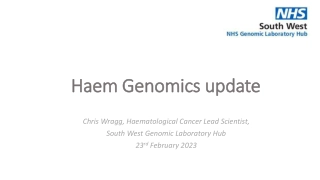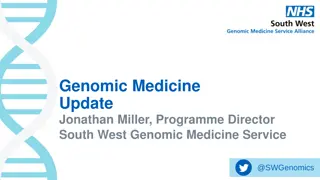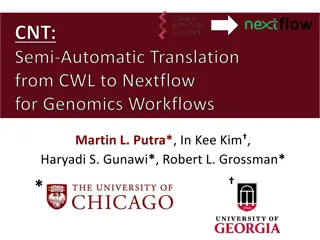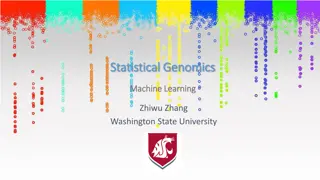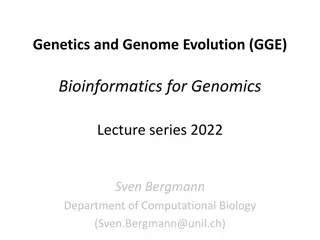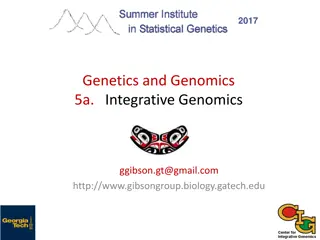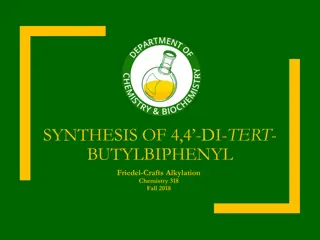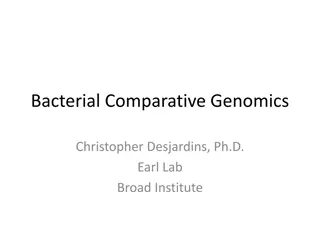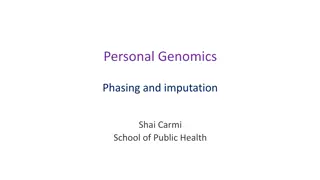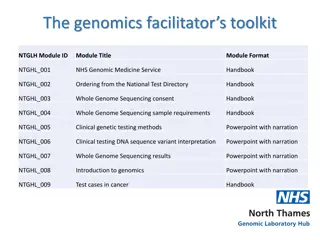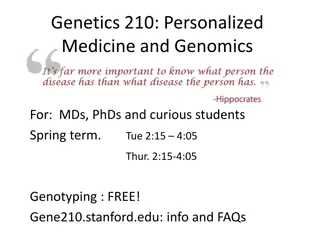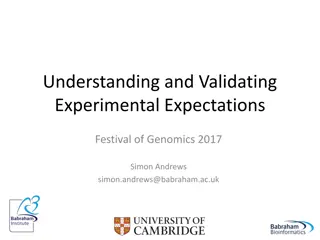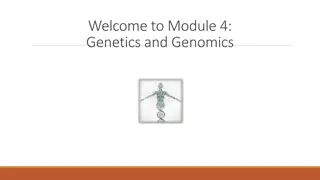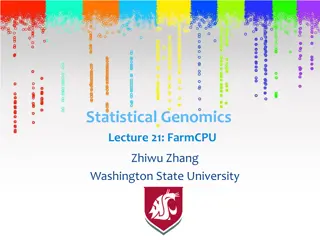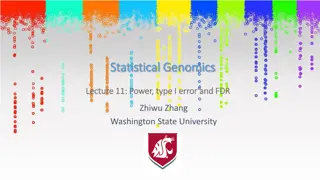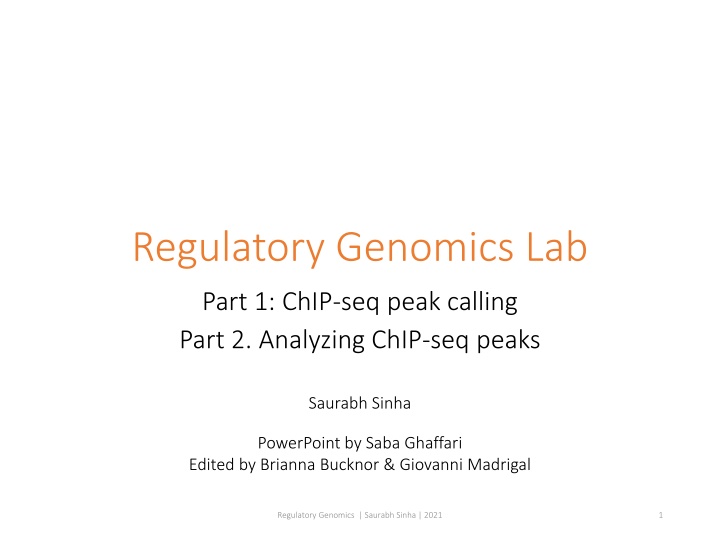
ChIP-seq Peak Calling & Analysis in Regulatory Genomics Lab
Learn how to perform ChIP-seq peak calling and analysis in the Regulatory Genomics Lab, covering topics such as mapping NGS reads, calling peaks with MACS2, analyzing ChIP-seq peaks, and using command-line tools for motif discovery.
Download Presentation

Please find below an Image/Link to download the presentation.
The content on the website is provided AS IS for your information and personal use only. It may not be sold, licensed, or shared on other websites without obtaining consent from the author. If you encounter any issues during the download, it is possible that the publisher has removed the file from their server.
You are allowed to download the files provided on this website for personal or commercial use, subject to the condition that they are used lawfully. All files are the property of their respective owners.
The content on the website is provided AS IS for your information and personal use only. It may not be sold, licensed, or shared on other websites without obtaining consent from the author.
E N D
Presentation Transcript
Regulatory Genomics Lab Part 1: ChIP-seq peak calling Part 2. Analyzing ChIP-seq peaks Saurabh Sinha PowerPoint by Saba Ghaffari Edited by Brianna Bucknor & Giovanni Madrigal Regulatory Genomics | Saurabh Sinha | 2021 1
Part 1: ChIPSeq Peak Calling Data set: 2 cell lines: G1E and G1E_ER4 2 data sets for each cell line: ChIP-seq for CTCF and control Steps: 1. 2. 3. 4. Start with a data set with ChIP-seq reads, do quality control Map (align) reads to a reference genome using Bowtie2. Call peaks from aligned reads using MACS2 Identify ChIP peaks that differ between G1E_ER4 (stimulated) and G1E (un-stimulated) cell lines Bowtie2. MACS2. Variations on the theme: Peak calling on ChIP-seq data with and without using corresponding control data Regulatory Genomics | Saurabh Sinha | 2021 2
Part 2: Analyzing ChIPSeq Peaks Use command line tools to manipulate a ChIP-seq peak set for TF called BIN in D. melanogaster 1 2 3 Selected ChIP peaks (100 strong binding sites of the TF) TF Motif inferred from selected ChIP peaks MEME CHIP-seq peaks (Binding sites of a TF) DNA sequences of selected ChIP peaks Subject peak sets to MEME suite for computational motif discovery In the end, compare MEME-reported motifs with Fly Factor Survey motifs for BIN TF Regulatory Genomics | Saurabh Sinha | 2021
Part 1: ChIPSeq Peak Calling Slides by Shayan Tabe Bordbar Regulatory Genomics | Saurabh Sinha | 2021 4
Introduction This goals of the lab are as follows: 1. Learn how to map Next Generation Sequencing (NGS) reads to a reference genome using Bowtie2. Bowtie2. 2. Demonstrate how to call peaks from aligned reads (in SAM format) using MACS2 MACS2. Regulatory Genomics | Saurabh Sinha | 2021 5
Start the VM Follow instructions for starting VM (This is the Remote Desktop software). The instructions are different for UIUC and Mayo participants. Find the instructions for this on the course website under Lab Set-up: https://publish.illinois.edu/compgenomicscourse/2022-schedule/ Regulatory Genomics | Saurabh Sinha | 2021 6
Step 0A: Accessing the IGB Biocluster Open MobaXterm MobaXterm 1. Select Session Session 2. Under SSH textbox type: SSH, in the remote host remote host biologin.igb.illinois.edu 3. Click OK 4. Enter login credentials assigned to you; example, user class00. OK Now you are all set! Now you are all set! 7
Step 0B: Lab Setup The lab is located in the following directory: /home/classroom/mayo/2020/05_Epigenomics/ Following commands will copy a shell script -designed to prepare the working directory- to your home directory. Follow these steps to copy and then submit the script as a job to biocluster: $ cd ~/ # Note ~ is a symbol in Unix paths referring to your home directory $ cp /home/classroom/mayo/2020/05_Epigenomics/src/prep-directory.sh ./ # Copies prep-directory.sh script to your working directory. $ sbatch prep-directory.sh # submits a job to biocluster to populate your home directory with necessary files $ squeue u <userID> # to check the status of the submitted job 8 This is the same as your login. Do not include < > ex: $ squeue u classxx
Step 0C: Working directory: data Navigate to the created directory for this exercise and look what data folder contains. $ cd 05_Epigenomics Note: Note: G1E cell lines are erythroid, red blood cell, cell lines missing the GATA-1 gene. $ ls # output should be: GATA-1 is crucial for the maturation of erythroid cells. # data results src $ ls data/ G1E_E4R cell lines conditionally express GATA-1 in the presence of estradiol, enabling erythroid maturation. $ ls data/index # output should be: # mm9.1.bt2 mm9.2.bt2 mm9.3.bt2 mm9.4.bt2 # mm9.rev.1.bt2 mm9.rev.2.bt2 mm9.zip Filename Description A sample ChIP-seq dataset on CTCF in G1E_ER4 cells, reads have been reduced to those mapping to chr19 for demonstration use. G1E_ER4_CTCF_chr19.fastqsanger G1E_ER4_input_chr19.fastqsanger Control DNA taken from chr19. G1E_CTCF.fastqsanger CTCF Chip for G1E line. G1E_input.fastqsanger Control for G1E line. 9
Step 0D: Working directory: scripts Navigate to the directory containing the scripts and look what s inside. $ cd src $ ls *.sh # lists the scripts to be used in this lab: # fastx_summary.sh # run_bowtie2.sh # run_macs2_noControl.sh run_macs2_withControl.sh run_macs2_noER.sh # bedtools_overlap_1.sh bedtools_overlap_2.sh # bedtools_subtract_1.sh bedtools_subtract_2.sh Regulatory Genomics | Saurabh Sinha | 2021 10
Read Mapping and Peak Calling In this exercise, we will map ChIP Reads to a reference genome using Bowtie2 call peaks among the mapped reads using MACS2 Bowtie2 and MACS2. Chip-Seq Peak Calling | Lisa Stubbs | 2019 11
Step 1: FASTQ Summary Statistics In this step, we will gather summary statistics of ChIP data for quality control. We use FASTX-Toolkit to get statistics on the quality and content of each column of fastq files (sequencing reads). fastx_quality_stats is the name of the tool used from FASTX-Toolkit. How to Use [Do Do NOT NOT run run the following commands]: $ fastx_quality_stats -i <input.fastq> -o <output_summary.txt> fastx_summary.sh uses fastx_quality_stats to get summary reports for all four provided fastq files. RUN RUN the following command: $ cd ~/05_Epigenomics/src/ $ sbatch fastx_summary.sh # OUTPUT in ~/05_Epigenomics/results/ $ squeue u <userID> # to check the status of the submitted job 12 This is the same as your login. Do not include < > ex: $ squeue u classxx
Please do not try to Run the commands in this slide. This is just to explain what the script that we just ran (fastx_summary.sh ) is supposed to do in more detail. What s inside the fastx_summary.sh fastx_summary.sh script? #!/bin/bash #SBATCH -c 4 #SBATCH --mem 8000 #SBATCH -A Mayo_Workshop #SBATCH -J fastx_summ #SBATCH -o fastx_summ.%j.out #SBATCH -e fastx_summ.%j.err #SBATCH -p classroom Tells the cluster job manager what resources you want (4 CPUs, 8GB memory, run on the classroom nodes, and name the job fastx_summ Load the software. We are using a tool called FASTX- Toolkit to generate some basic stats on the fastq files. # load the tool environment module load FASTX-Toolkit # this is our input (fastq) export FASTQ_1=../data/G1E_CTCF.fastqsanger export FASTQ_2=../data/G1E_input.fastqsanger export FASTQ_3=../data/G1E_ER4_CTCF_chr19.fastqsanger export FASTQ_4=../data/G1E_ER4_input_chr19.fastqsanger # this is our output (summaries) export OUT_1=../results/G1E_CTCF_summary.txt export OUT_2=../results/G1E_input_summary.txt export OUT_3=../results/G1E_ER4_CTCF_chr19_summary.txt export OUT_4=../results/G1E_ER4_input_chr19_summary.txt Create shortcut names for input and output files. fastx_quality_stats -i $FASTQ_1 -o $OUT_1 fastx_quality_stats -i $FASTQ_2 -o $OUT_2 fastx_quality_stats -i $FASTQ_3 -o $OUT_3 fastx_quality_stats -i $FASTQ_4 -o $OUT_4 These commands, not to be run by you, execute the fastx_quality_score tool on all four input fastq files. 13
Step 1: FASTQ Summary Statistics To view one of the summary files use: $ more ~/05_Epigenomics/results/G1E_CTCF_summary.txt # shows beginning of G1E_CTCF_summary.txt file # To get the length of the reads use: $ cat ~/05_Epigenomics/results/G1E_CTCF_summary.txt | wc -l # you should get 37 Tip: Note: Note: This is a lowercase L, not the #1 Pressing enter more lines appear. Pressing d d will allow you to exit out of seeing the summary stats and enter the next line of code. enter will make Discussion Discussion How long are these reads? What is the median quality at the last position? View and explore other summary files: G1E_CTCF_summary.txt G1E_input_summary.txt G1E_ER4_CTCF_chr19_summary.txt G1E_ER4_input_chr19_summary.txt Chip-Seq Peak Calling | Lisa Stubbs | 2019 14
Step 2: Map ChIP-Seq Reads to MM9 Genome Next, we will map the reads in G1E_E4R_CTCF_chr9.fastqsanger G1E_E4R_CTCF_chr9.fastqsanger to the mouse genome using Bowtie2. Bowtie2. usage: box. This is just to explain the arguments to bowtie2 Please do not try to Run the commands in the first bowtie2 [options] x <base name of index files> \ -U <in_file_name> \ -S <out_file_name.sam> --sensitive The index files are available on Biocluster and you do not need to download them now. However it can be downloaded from [Please do ftp://ftp.ccb.jhu.edu/pub/data/bowtie2_indexes/mm9.zip Script run_bowtie2.sh uses bowtie2 on all four input fastq files and maps them to mm9 genome. do not not download now]: $ cd ~/05_Epigenomics/src/ $ sbatch run_bowtie2.sh # OUTPUT in ~/05_Epigenomics/results/Bowtie_output $ squeue u <userID> # to check the status of the submitted job Chip-Seq Peak Calling | Lisa Stubbs | 2019 15
There are other parameters that can be specified for a more controlled use of Bowtie2. In particular, following are some preset options that can be used to modify the speed and sensitivity of the tool: --very-fast --fast --sensitive (default) --very-sensitive More information on the Bowtie2 can be found in its well-written manual: http://bowtie-bio.sourceforge.net/bowtie2/manual.shtml Chip-Seq Peak Calling | Lisa Stubbs | 2019 16
Please do not try to Run the commands in this slide. This is just to explain what the script that we just ran (run_bowtie2.sh) is supposed to do in more detail. What s inside the run_bowtie2.sh script? #!/bin/bash #SBATCH -c 4 #SBATCH --mem 8000 #SBATCH -A Mayo_Workshop #SBATCH -J bowtie2_test #SBATCH -o bowtie2_test.%j.out #SBATCH -e bowtie2_test.%j.err #SBATCH -p classroom # load the tool environment module load Bowtie2/ # this is our input (fastq) export BOWTIE_INP_1=../data/G1E_ER4_CTCF_chr19.fastqsanger export BOWTIE_INP_2=../data/G1E_ER4_input_chr19.fastqsanger export BOWTIE_INP_3=../data/G1E_CTCF.fastqsanger export BOWTIE_INP_4=../data/G1E_input.fastqsanger mkdir -p ../results/Bowtie_output # this is our output (SAM) export BOWTIE_OUT_1=../results/Bowtie_output/G1E_ER4_CTCF_chr19.sam export BOWTIE_OUT_2=../results/Bowtie_output/G1E_ER4_input_chr19.sam export BOWTIE_OUT_3=../results/Bowtie_output/G1E_CTCF_chr19.sam export BOWTIE_OUT_4=../results/Bowtie_output/G1E_input_chr19.sam # PATH TO the mm9 dm3 index file along with their common prefix (mm9) export GENOME_MM9_BOWTIE2=../data/index/mm9 Tells the cluster job manager what resources you want (4 CPUs, 8GB memory, run on the classroom nodes, and name the job bowtie2_test Load the software. We are using a tool called Bowtie2 to Map fastq files to mm9 mouse genome. Create shortcut names for input and output files, as well as mm9 genome index files prefix. bowtie2 -q -x $GENOME_MM9_BOWTIE2 -U $BOWTIE_INP_1 -S $BOWTIE_OUT_1 bowtie2 -q -x $GENOME_MM9_BOWTIE2 -U $BOWTIE_INP_2 -S $BOWTIE_OUT_2 bowtie2 -q -x $GENOME_MM9_BOWTIE2 -U $BOWTIE_INP_3 -S $BOWTIE_OUT_3 bowtie2 -q -x $GENOME_MM9_BOWTIE2 -U $BOWTIE_INP_4 -S $BOWTIE_OUT_4 Run bowtie2 tool on all four input fastq files Chip-Seq Peak Calling | Lisa Stubbs | 2019 17
Step 2: Map ChIP-Seq Reads to MM9 Genome $ head -40 ~/05_Epigenomics/results/Bowtie_output/G1E_ER4_CTCF_chr19.sam # view the first 40 lines of an output SAM file View and explore other SAM files: G1E_CTCF_chr19.sam G1E_input_chr19.sam G1E_ER4_CTCF_chr19.sam G1E_ER4_input_chr19.sam You can find more information on the structure of SAM files in the following links: https://www.samformat.info/sam-format-flag https://en.wikipedia.org/wiki/SAM_%28file_format%29 Chip-Seq Peak Calling | Lisa Stubbs | 2019 18
Step 3A: Calling Peaks with MACS2 With our mapped ChiP-Seq reads, we now want to call peaks. We use MACS2 MACS2 for this purpose. . usage: Please do not try to Run the commands in the following box. This is just to explain the Please do not try to Run the commands in the following box. This is just to explain the arguments to macs2 arguments to macs2 macs2 callpeak t <path_to_treatment_input_alignment> \ -c < path_to_control_input_alignment > \ # optional -g <effective_genome_size> \ # use mm for mouse -n <prefix_for_naming_output_files> A useful tutorial for MACS2 can be found here: https://hbctraining.github.io/Intro-to-ChIPseq/lessons/05_peak_calling_macs.html Chip-Seq Peak Calling | Lisa Stubbs | 2019 19
Step 3A: Calling Peaks with MACS2 Script run_macs2_noControl.sh runs MACS2 to call peaks for G1E_ER4_CTCF_chr19.sam with the default parameters. Note that this macs2 run is performed without using input from control experiment. $ cd ~/05_Epigenomics/src/ $ sbatch run_macs2_noControl.sh # OUTPUT in ~/05_Epigenomics/results/MACS2_output/CTCF_ER4_noControl* $ squeue u <userID> # to check the status of the submitted job Chip-Seq Peak Calling | Lisa Stubbs | 2019 20
Please do not try to Run the commands in this slide. This is just to explain what the script that we just ran (run_macs2_noControl.sh) is supposed to do in more detail. What s inside the run_macs2_noControl.sh script? #!/bin/bash #SBATCH -c 1 #SBATCH --mem 8000 #SBATCH -A Mayo_Workshop #SBATCH -J macs2_noC #SBATCH -o macs2_noC.%j.out #SBATCH -e macs2_noC.%j.err #SBATCH -p classroom Tells the cluster job manager what resources you want (1 CPU, 8GB memory, run on the classroom nodes, and name the job macs2_noC Load the software. We use a tool called MACS2 to call ChIP peaks. # load the tool environment module load MACS2/2.1.2-IGB-gcc-4.9.4-Python-2.7.13 # this is our input (SAM) export MACS_TREAT=../results/Bowtie_output/G1E_ER4_CTCF_chr19.sam Create shortcut names for input alignment file, output directory, and output prefix. # this is our output_directory export MACS_OUT_DIR=../results/MACS2_output # this is our output prefix export MACS_OUT_1=CTCF_ER4_noControl macs2 callpeak -t $MACS_TREAT -g mm -f SAM --outdir $MACS_OUT_DIR -n $MACS_OUT_1 This command, not to be run by you directly, executes the MACS2 tool on G1E_ER4_CTCF_chr19.sam without using the control experiment 21
Step 3A: Calling Peaks with MACS2 Number of peaks called without using a control experiment input can be obtained using: $ cat ../results/MACS2_output/CTCF_ER4_noControl_peaks.narrowPeak | wc -l # You should get 626 $ head ../results/MACS2_output/CTCF_ER4_noControl_peaks.narrowPeak Here are the fields (columns) of a .narrowPeak file: screenshot from: https://hbctraining.github.io/Intro-to-ChIPseq/lessons/05_peak_calling_macs.html Chip-Seq Peak Calling | Lisa Stubbs | 2019 22
Call ChIP-Seq Peaks with a Control Sample We will perform the same procedure we did in the previous exercise. This time though, we will work with a control sample in addition to the treated one. Chip-Seq Peak Calling | Lisa Stubbs | 2019 23
Step 3B: Calling Peaks with MACS2 using Control Chip-Seq Reads Script run_macs2_noControl.sh runs MACS2 to call peaks for G1E_ER4_CTCF_chr19.sam with the default parameters. Note that this macs2 run is performed using additional input from control experiment (G1E_ER4_input_chr19.sam ). $ cd ~/05_Epigenomics/src/ $ sbatch run_macs2_withControl.sh # OUTPUT in ~/05_Epigenomics/results/MACS2_output/CTCF_ER4_withControl* $ squeue u <userID> # to check the status of the submitted job Number of peaks called using the additional control experiment input can be obtained using: $ cat ../results/MACS2_output/CTCF_ER4_withControl_peaks.narrowPeak | wc -l # You should get 528 Chip-Seq Peak Calling | Lisa Stubbs | 2019 24
Please do not try to Run the commands in this slide. This is just to explain what the script that we just ran (run_macs2_withControl.sh) is supposed to do in more detail. What s inside the run_macs2_withControl.sh script? #!/bin/bash #SBATCH -c 1 #SBATCH --mem 8000 #SBATCH -A Mayo_Workshop #SBATCH -J macs2_wC #SBATCH -o macs2_wC.%j.out #SBATCH -e macs2_wC.%j.err #SBATCH -p classroom Tells the cluster job manager what resources you want (1 CPU, 8GB memory, run on the classroom nodes, and name the job macs2_wC Load the software. We use a tool called MACS2 to call ChIP peaks. # load the tool environment module load MACS2/2.1.2-IGB-gcc-4.9.4-Python-2.7.13 # this is our input (SAM) export MACS_TREAT=../results/Bowtie_output/G1E_ER4_CTCF_chr19.sam export MACS_CONTROL=../results/Bowtie_output/G1E_ER4_input_chr19.sam # this is our output directory export MACS_OUT_DIR=../results/MACS2_output # this is our output prefix export MACS_OUT_1=CTCF_ER4_withControl Create shortcut names for treatment and control input alignment files, output directory, and output prefix. macs2 callpeak -t $MACS_TREAT -c $MACS_CONTROL -g mm -f SAM outdir \ $MACS_OUT_DIR -n $MACS_OUT_1 This command, not to be run by you directly, executes the MACS2 tool on G1E_ER4_CTCF_chr19.sam while using G1E_ER4_input_chr19.sam as the control experiment. 25
Step 3C: Calling Peaks with MACS2 on Chip-Seq Reads for un-stimulated cells Script run_macs2_noER.sh runs MACS2 to call peaks for G1E_CTCF_chr19.sam with the default parameters. Note that this macs2 run is performed using additional input from control experiment (G1E_input_chr19.sam). $ cd ~/05_Epigenomics/src/ $ sbatch run_macs2_noER.sh # OUTPUT in ~/05_Epigenomics/results/MACS2_output/CTCF_noE2_* $ squeue u <userID> # to check the status of the submitted job Exercise: Find out the number of peaks called for this ChIP-Seq experiment Chip-Seq Peak Calling | Lisa Stubbs | 2019 26
Please do not try to Run the commands in this slide. This is just to explain what the script Please do not try to Run the commands in this slide. This is just to explain what the script that we just ran (run_macs2_noER.sh) is supposed to do in more detail. that we just ran (run_macs2_noER.sh) is supposed to do in more detail. What s inside the run_macs2_noER.sh script? #!/bin/bash #SBATCH -c 4 #SBATCH --mem 8000 #SBATCH -A Mayo_Workshop #SBATCH -J macs2_noER #SBATCH -o macs2_noER.%j.out #SBATCH -e macs2_noER.%j.err #SBATCH -p classroom Tells the cluster job manager what resources you want (1 CPU, 8GB memory, run on the classroom nodes, and name the job macs2_noER Load the software. We use a tool called MACS2 to call ChIP peaks. # load the tool environment module load MACS2/2.1.2-IGB-gcc-4.9.4-Python-2.7.13 # this is our input (SAM) export MACS_TREAT_NOER=../results/Bowtie_output/G1E_CTCF_chr19.sam export MACS_CONTROL_NOER=../results/Bowtie_output/G1E_input_chr19.sam # this is the output directory export MACS_OUT_DIR=../results/MACS2_output # this is our output prefix export MACS_OUT_1=CTCF_noE2 Create shortcut names for treatment and control input alignment files, output directory, and output prefix. macs2 callpeak -t $MACS_TREAT_NOER -c $MACS_CONTROL_NOER -g mm -f SAM outdir \ $MACS_OUT_DIR -n $MACS_OUT_1 This command, not to be run by you directly, executes the MACS2 tool on G1E_CTCF_chr19.sam while using G1E_input_chr19.sam as the control experiment. 27
MACS2 summary MACS2 creates two output files: _peaks.narrowPeak: BED6+4 format file which contains the peak locations together with peak summit, pvalue and qvalue. _peaks.xls: a tabular file which contains information about called peaks. Additional information includes pileup and fold enrichment Discussion Discussion 1. 2. 3. Examine the BED How many peaks are called when using a control sample? How does this compare to the previous situation where we only had experimental Chip-Seq reads? BED tracks. Chip-Seq Peak Calling | Lisa Stubbs | 2019 28
Identifying Differential Binding Sites In this exercise, we will identify binding sites exclusive to undifferentiated and differentiated cell lines as well as those common to both, using bedtools toolkit. Chip-Seq Peak Calling | Lisa Stubbs | 2019 29
Step 4A: Subtract Peaks Between Cell Lines we will use bedtools intersect tool from bedtools toolkit to identify CTCF peaks that are unique to the differentiated cell line: Usage: Usage: Please do not try to Run the commands in the following box. This is just to explain the arguments to bedtools $ bedtools intersect[options] a <first_interval.bed> \ -b <second_interval.bed> Specific options determine the behaviour of bedtools intersect, e.g. - -wa wa Write the original entry in A for each overlap. -wb wb Write the original entry in B for each overlap. -v v Only report those entries in A that have no overlap in B. As an example, following command finds entries in A.bed that are absent in B.bed: Please do not try to Run the commands in the following box. This is just to show an example. $ bedtools intersect v a A.bed b B.bed Here is a link to the manual for bedtools intersect: https://bedtools.readthedocs.io/en/latest/content/tools/intersect.html Chip-Seq Peak Calling | Lisa Stubbs | 2019 30
Step 4A: Subtract Peaks Between Cell Lines. Use the following command to find peaks in E2 treated cells that are absent in untreated cells: $ cd ~/05_Epigenomics/src/ $ sbatch bedtools_subtract_1.sh # OUTPUT in ~/05_Epigenomics/results/peak_inspection/CTCF_subtract_1.bed $ squeue u <userID> # to check the status of the submitted job The resulting BED differentiated differentiated cell line (G1E-ER4). BED file (CTCF_subtract_1.bed) contains peaks exclusive to the Discussion Discussion 1. How many peaks are exclusive to G1E-ER4? $ cat ~/05_Epigenomics/results/peak_inspection/CTCF_subtract_1.bed | wc -l # You should get 136 Chip-Seq Peak Calling | Lisa Stubbs | 2019 31
Please do not try to Run the commands in this slide. This is just to explain what the script that we just ran (bedtools_subtract_1.sh) is supposed to do in more detail. What s inside the bedtools_subtract_1.sh script? #!/bin/bash #SBATCH -c 1 #SBATCH --mem 8000 #SBATCH -A Mayo_Workshop #SBATCH -J bedtools_subt1 #SBATCH -o bedtools_subt1.%j.out #SBATCH -e bedtools_subt1.%j.err #SBATCH -p classroom Tells the cluster job manager what resources you want (1 CPU, 8GB memory, run on the classroom nodes, and name the job bedtools_subt1 # load the tool environment module load BEDTools Load the software. We use a tool called BEDTools to work with generated peak files. # this is our input (bed like) export PEAK_1=../results/MACS2_output/CTCF_ER4_withControl_peaks.narrowPeak export PEAK_2=../results/MACS2_output/CTCF_noE2_peaks.narrowPeak Create shortcut names for the two input bed files, and the output bed file. mkdir -p ../results/peak_inspection # this is our output (bed like) export OUT_1=../results/peak_inspection/CTCF_subtract_1.bed run bedtools intersect using the v flag to get the difference between the two bed files, and store the results in CTCF_subtract_1.bed bedtools intersect -v -a $PEAK_1 -b $PEAK_2 > $OUT_1 Chip-Seq Peak Calling | Lisa Stubbs | 2019 32
Step 4A: Subtract Peaks Between Cell Lines Redo Step1 only SWITCH untreated cells. use the following command to do just that: SWITCH the input order to get the peaks unique to the $ cd ~/05_Epigenomics/src/ $ sbatch bedtools_subtract_2.sh # OUTPUT in ~/05_Epigenomics/results/peak_inspection/CTCF_subtract_2.bed The resulting BED undifferentiated undifferentiated cell line (G1E). BED file (CTCF_subtract_2.bed) contains peaks exclusive to the Exercise: How many peaks are exclusive to the undifferentiated cell line? $ cat ~/05_Epigenomics/results/peak_inspection/CTCF_subtract_2.bed | wc -l # You should get 23 Chip-Seq Peak Calling | Lisa Stubbs | 2019 33
Please do not try to Run the commands in this slide. This is just to explain what the script that we just ran (bedtools_subtract_2.sh) is supposed to do in more detail. What s inside the bedtools_subtract_2.sh script? #!/bin/bash #SBATCH -c 1 #SBATCH --mem 8000 #SBATCH -A Mayo_Workshop #SBATCH -J bedtools_subt2 #SBATCH -o bedtools_subt2.%j.out #SBATCH -e bedtools_subt2.%j.err #SBATCH -p classroom Tells the cluster job manager what resources you want (1 CPU, 8GB memory, run on the classroom nodes, and name the job bedtools_subt2 Load the software. We use a tool called BEDTools to work with generated peak files. # load the tool environment module load BEDTools # this is our input (bed like) export PEAK_1=../results/MACS2_output/CTCF_ER4_withControl_peaks.narrowPeak export PEAK_2=../results/MACS2_output/CTCF_noE2_peaks.narrowPeak Create shortcut names for the two input bed files, and the output bed file. mkdir -p ../results/peak_inspection # this is our output (bed like) export OUT_1=../results/peak_inspection/CTCF_subtract_2.bed This command, not to be run by you directly, executes the bedtools intersect using the v flag to get the difference between the two bed files, and store the results in CTCF_subtract_2.bed bedtools intersect -v -a $PEAK_2 -b $PEAK_1 > $OUT_1 Chip-Seq Peak Calling | Lisa Stubbs | 2019 34
Step 4B: Intersect Peaks Between Cell Lines Following command finds entries in A.bed that overlap with at least one entry in B.bed: Please do not try to Run the command in the following box. This is just to show an example. $ bedtools intersect wa a A.bed b B.bed Use the following command to find peaks in E2 treated cells that overlap with peaks in the untreated cells: $ cd ~/05_Epigenomics/src/ $ sbatch bedtools_overlap_1.sh # OUTPUT in ~/05_Epigenomics/results/peak_inspection/CTCF_overlap_1.bed The resulting BED cell line (G1E_ER4) that overlap with peaks in the undifferentiated cell line (G1E). BED file (CTCF_overlap_1.bed) contains peaks from the differentiated Chip-Seq Peak Calling | Lisa Stubbs | 2019 35
Please do not try to Run the commands in this slide. This is just to explain what the script that we just ran (bedtools_overlap_1.sh) is supposed to do in more detail. What s inside the bedtools_overlap_1.sh script? #!/bin/bash #SBATCH -c 4 #SBATCH --mem 8000 #SBATCH -A Mayo_Workshop #SBATCH -J bedtools_ovl1 #SBATCH -o bedtools_ovl1.%j.out #SBATCH -e bedtools_ovl1.%j.err #SBATCH -p classroom Tells the cluster job manager what resources you want (1 CPU, 8GB memory, run on the classroom nodes, and name the job bedtools_ovl1 # load the tool environment module load BEDTools Load the software. We use a tool called BEDTools to work with generated peak files. # this is our input (bed like) export PEAK_1=../results/MACS2_output/CTCF_ER4_withControl_peaks.narrowPeak export PEAK_2=../results/MACS2_output/CTCF_noE2_peaks.narrowPeak mkdir -p ../results/peak_inspection # this is our output (bed like) export OUT_1=../results/peak_inspection/CTCF_overlap_1.bed Create shortcut names for the two input bed files, and the output bed file. bedtools intersect -wa -a $PEAK_1 -b $PEAK_2 > $OUT_1 This command, not to be run by youdirectly, executes the bedtools intersect using the wa flag to get the entries in the first file (-a) that have an overlap with an entry in second input file (-b) and store the results in CTCF_overlap_1.bed Chip-Seq Peak Calling | Lisa Stubbs | 2019 36
Part 2: Analyzing ChIPSeq Peaks Slides by Shayan Tabe Bordbar Chip-Seq Peak Calling | Lisa Stubbs | 2019 37
In this lab, we will do the following: In this lab, we will do the following:. Use command line tools to manipulate a ChIP track for BIN TF in D. melanogaster Subject peak sets to MEME suite. Compare MEME motifs with Fly Factor Survey motifs for BIN TF. Chip-Seq Peak Calling | Lisa Stubbs | 2019 38
1 2 3 Selected ChIP peaks (100 strong binding sites of the TF) TF Motif inferred from selected ChIP peaks MEME CHIP-seq peaks (Binding sites of a TF) DNA sequences of selected ChIP peaks Chip-Seq Peak Calling | Lisa Stubbs | 2019
In In MobaXterm MobaXterm Step 0A: Lab Setup The lab is located in the following directory: /home/classroom/mayo/2021/06_Regulatory_Genomics/ Following commands will copy a shell script -designed to prepare the working directory- to your home directory. Follow these steps to copy and then submit the script as a job to biocluster: $ cd ~/ # Note ~ is a symbol in Unix paths referring to your home directory $ rm ./prep-directory.sh # Remove any existing copy of this file from your working directory $ cp /home/classroom/mayo/2020/06_Regulatory_Genomics/src/prep-directory.sh ./ # Copies prep-directory.sh script to your working directory. $ sbatch prep-directory.sh # submits a job to biocluster to populate your home directory with necessary files $ squeue u <userID> # to check the status of the submitted job This is the same as your login. Do not include < > ex: $ squeue u classxx 40
Step 0B: Working directory: data Navigate to the created directory for this exercise and look what data folder contains. $ cd 06_Regulatory_Genomics Name Description $ ls ChIP peaks for BIN transcription factor in GFF format # output should be: BIN_Fchip_s11_1000.gff # data results src $ ls data/ Drosophila Melanogaster genome # BIN_Fchip_s11_1000.gff dm3.fasta # dm3.fasta # flygenes_vm.bed Coordinates of all Drosophila genes in BED format flygenes_vm.bed Chip-Seq Peak Calling | Lisa Stubbs | 2019 41
Step 0C: Working directory: scripts Navigate to the directory containing the scripts and look what s inside. $ cd src $ ls *.sh # lists the scripts to be used in this lab: # get_closest_genes.sh get_sequence.sh get_top100.sh Chip-Seq Peak Calling | Lisa Stubbs | 2019 42
Computational Prediction of Motifs In this exercise, after performing various file manipulations, we will use the MEME suite to identify a motif from the top 100 ChIP regions. Subsequently, we will compare our predicted motif with the experimentally validated motif for BIN at Fly Factor Survey. Regulatory Genomics | Saurabh Sinha | 2021 43
1 2 3 Selected ChIP peaks (100 strong binding sites of the TF) TF Motif inferred from selected ChIP peaks MEME CHIP-seq peaks (Binding sites of a TF) DNA sequences of selected ChIP peaks Regulatory Genomics | Saurabh Sinha | 2021
Step 1: Obtain the top 100 strongest ChIP peaks We will use sort command, to sort the peaks based on their score and then take the top 100 peaks. Use the following line to get the top 100 chip peaks from the original ChIP gff file. $ cd ~/06_Regulatory_Genomics/src/ $ head ~/06_Regulatory_Genomics/data/BIN_Fchip_s11_1000.gff # The above command shows the first few lines of the file $ sbatch get_top100.sh # OUTPUT in ~/06_Regulatory_Genomics/results/Top_100_peaks.gff Regulatory Genomics | Saurabh Sinha | 2021 45
Please do not try to Run the commands in this slide. This is just to explain what the script Please do not try to Run the commands in this slide. This is just to explain what the script that we just ran (get_top100.sh) is supposed to do in more detail. that we just ran (get_top100.sh) is supposed to do in more detail. What s inside the get_top100.sh script? #!/bin/bash #SBATCH -c 1 #SBATCH --mem 8000 #SBATCH -A Mayo_Workshop #SBATCH -J getTop100 #SBATCH -o getTop100.%j.out #SBATCH -e getTop100.%j.err #SBATCH -p classroom Tells the cluster job manager what resources you want (1 CPU, 8GB memory), run on the classroom nodes, and name the job getTop100 # this is our input (gff) export TOBESORTED=../data/BIN_Fchip_s11_1000.gff Create shortcut name for input ChIP peak file in GFF format. sort -k 6,6nr $TOBESORTED | head -100 > ../results/Top_100_peaks.gff This command, not to be run by you directly, executes the Linux sort command to sort the file based on the numeric score stored in the 6th column of the gff file (ChIP score). [ k flag introduces the column to be sorted by. nr nr notes that we desire a n numeric sort in r reverse order.] Output is directed to (>) Top_100_peaks.gff file. Regulatory Genomics | Saurabh Sinha | 2021 46
1 2 3 Selected ChIP peaks (100 strong binding sites of the TF) TF Motif inferred from selected ChIP peaks MEME CHIP-seq peaks (Binding sites of a TF) DNA sequences of selected ChIP peaks Regulatory Genomics | Saurabh Sinha | 2021
Step 2: Extract DNA sequence of Top 100 ChIP Regions We will use a getfasta tool from bedtools toolkit to get the DNA sequence for the top 100 ChIP peaks. Usage: Please do not try to Run the commands in the first box. This is just to explain the arguments to bedtools getfasta $ bedtools getfasta [options] fi <genome_file_name> > \ # specifies the path to the genome sequence in FASTA format -bed <file_name.bed> # specifies the path to coordinates of input regions in (BED/GFF/VCF) # formats Script get_sequence.sh uses Bedtools getfasta to get the sequence corresponding to peaks stored in Top_100_peaks.gff. Run the following command: $ cd ~/06_Regulatory_Genomics/src/ $ sbatch get_sequence.sh # OUTPUT in ~/06_Regulatory_Genomics/results/BIN_top_100.fasta $ squeue u <userID> Regulatory Genomics | Saurabh Sinha | 2021 48
Please do not try to Run the commands in this slide. This is just to explain what the script that we just ran (get_sequence.sh) is supposed to do in more detail. What s inside the get_sequence.sh script? #!/bin/bash #SBATCH -c 1 #SBATCH --mem 8000 #SBATCH -A Mayo_Workshop #SBATCH -J get_sequence #SBATCH -o get_sequence.%j.out #SBATCH -e get_sequence.%j.err #SBATCH -p classroom Tells the cluster job manager what resources you want (1 CPU, 8GB memory, run on the classroom nodes, and name the job get_sequence Load the software. We use a tool called BEDTools to work with peak files. # load the tool environment module load BEDTools # this is our input (dm genome in fasta format) export GENOME_DM3_FASTA=../data/dm3.fasta export INPUT_CHIP=../results/Top_100_peaks.gff export OUTPUT_NAME=../results/BIN_top_100.fasta Create shortcut names for input genome, input ChIP peak file and output FASTA file. # use bedtools bedtools getfasta -fi $GENOME_DM3_FASTA -bed $INPUT_CHIP | fold -w 60 > $OUTPUT_NAME This command, not to be run by you directly, executes the bedtools getfasta to get the DNA sequence in dm3.fasta genome corresponding to coordinates contained in Top_100_peaks.gff fold w 60 ensures that the width of lines in the output file does not exceed 60 characters. results are directed to (>) BIN_top_100.fasta Regulatory Genomics | Saurabh Sinha | 2021 49
Note that output of get_sequence.sh (BIN_top_100.fasta) has already been copied to the VM to be used in the next step. Regulatory Genomics | Saurabh Sinha | 2021 50

